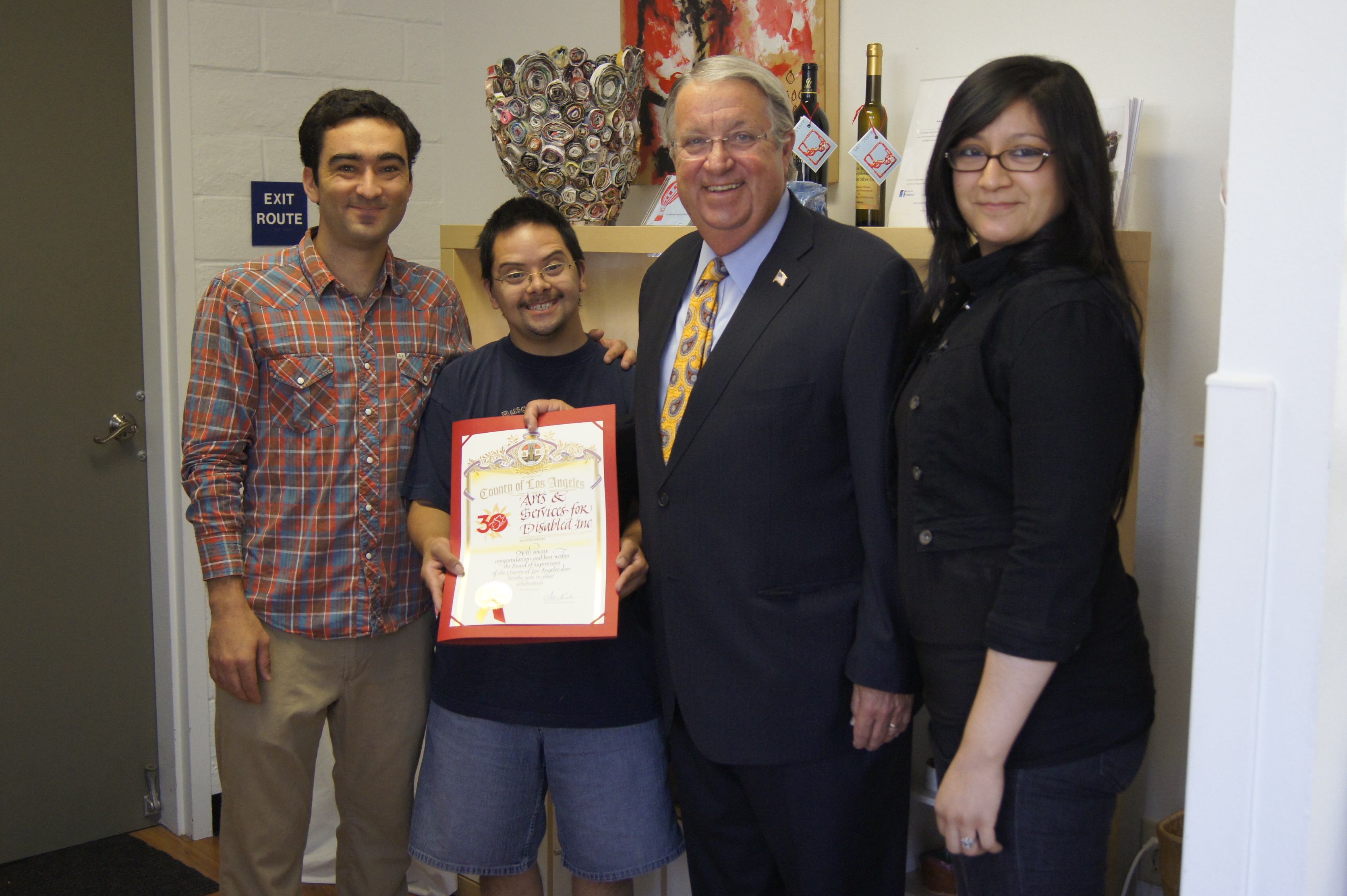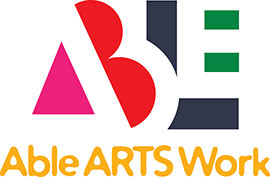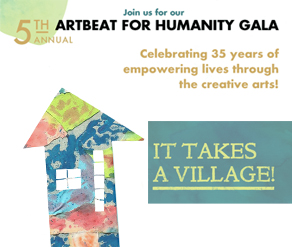In a new weekly series where we shine the spotlight on all the hard work non-profits are doing around the globe to enrich the lives of those facing adversity, we are highlighting the wonderful efforts of Able ARTS Work (formerly known as Arts & Services for Disabled, Inc.), whose primary mission is to provide lifelong learning, community service and vocational opportunities through the creative arts for people with disabilities of all ages in an environment of warmth, encouragement and inclusion.
Their belief is: “We believe all peope regardless of functional capability, have a right and responsibility, to contribute to the well being of their community and have a vocation of their choosing should have access to an informed and supportive community, which must play a vital role in removing the barriers to full involvement and inclusion. They should have access to the expressive arts in vocation, education, leisure, health and wellness. They should have the right to express and practice their cultural and artistic heritage.We believe all people regardless of functional capability should be treated with dignity and respect, thus our philosophy and mission.”
We caught up with founder, Helen Dolas, to discover more about the organization in this insightful and heartfelt interview below:
Q) You have been with Able ARTS Work (AAW) for 35 years, how did AAW come about?
A) In 1982, as a freshly minted Music Therapist, I launched Able ARTS Work, a new, innovative nonprofit dedicated to using the creative arts as therapy to help adults living with intellectual and developmental disabilities, rather than adding arts as an ancillary activity to a therapeutic program. Starting with three clients in a Parks & Recreation building in Long Beach, I built a curriculum using the creative arts – music, rhythm, painting, drawing, drama and dance – to enrich and empower their lives. It took more than two years, even armed with undisputed evidence-based research, to persuade leaders in the California Department of Developmental Disabilities that options were too limited for disabled individuals after they left the public school system, but after much persistence, we became the first arts-based program to be funded by Regional Centers.

Q) In that time, you must have seen some incredible things and had some moments which would have left you emotiomal, can you recount just a few of those instances which really stand out in your mind?
A) There are too many to list, but one of our latest and greatest stories is of Maria, a resident artist at our Cultural Education Center for the Arts (CECA), one of our 4 adult day programs located in Hawthorne, CA. Maria came to us in her early 20s, and spending her life in a wheelchair without the ability to speak, she had never been able to communicate with family or friends. After spending time getting to know her, an art therapist adapted a paintbrush so Maria was able to use it as a head wand, knowing that she had the mobility to use her head to paint on canvas. Maria selected paint, and then proceeded to write the word “Hello.” The staff, and her family and friends when they found out, were stunned, as they had no idea that she could read or write. Giving Maria an outlet of communication opened doors for her as an individual and an artist. Since that moment, Maria’s expectations of what she wanted to do in her life expanded. Since that day in 2013, she has exhibited her artwork twice at the Museum of Latin American Art, participated in an artists Q & A and has also had her own solo show at the ARTifact Gallery in Hawthorne. Maria’s biggest influence is Frida Kahlo, whom she likes to portray through photography. The possibilities are endless for Maria, she is building her body of work to keep doing what she loves.
Another example is of Sergio. When he started attending our day program he had extreme reservations about interacting or even sitting next to a person who had a severe disability. He was monolingual and set in his ways but over time, as he invested himself in the art forms he was connecting with, he started to break through those obstacles which prevented him from reaching out or connecting with his peers who were in wheelchairs or those who had a different disability that he did. Just a few years after joining us, Sergio became a fluent English speaker, a leader when helping those who needed a little extra support and often acted as ambassador of our organization and the first to welcome anyone who walked in the door.
Q) Life for everyone has its ups and downs, but for those with disabilities, it’s another battle. Can you explain some of them challenges they face?
We never forget that are two important people relying on us when we fill a prescription visit site or a user may detect other downsides than the ones listed above. Vacuum devises and MUSE have all but disappeared from Urology. The National Board of Examination recently published the list of 132 such medical teachers.
A) Many people with disabilities do not have their own voice to advocate for themselves, and many do not have family around to do so for them either. There is a misconception that they are incapable of learning, growing and advancing, therefor leading them to be locked away from community for so many years. Furthermore, adults with disabilities have an even bigger hardship, as once they have transitioned out of the school system, options for where they can go after are extremely limited. Funding for adults is not easy to come by, as many people are biased towards giving to children rather than adults. Able ARTS Works provides an unconditional approach of education and therapy through the arts to these individuals who now flourish given the opportunity through Able ARTS Work’s “Love Before Learning” mission and philosophy based on Maslow’s Hierarchy of Needs.

Q) How does the AAW assist them with having a better, more fulfilled life?
A) Able ARTS Work is an untraditional response to the educational needs of the developmentally disabled population from the school system. We provide various creative outlets for self-expression, increasing self-awareness and individuality. Once the communication barrier is broken and our students are able to express themselves through choice, they are able to thrive and develop their own personal path. We encourage our students to fulfill various roles through what they learn at programs as well as out in the community at workshops, events, outings and gallery exhibitions. Many of our students are able to explore new roles through community inclusion such as teaching, mentorship and leadership.
Able ARTS Work also serves to prepare those who are developmentally disabled for a traditional post-secondary education, encouraging interaction between children with and without disabilities, contributing to an inclusive and supportive community inside and outside of the classroom.
Today, Able ARTS Work has four campuses located in Long Beach and the South Bay, offers transportation services to clients, provides a Mobile Arts Program for students who are homebound due to fragile health or other reasons, has launched a clinic for children and adolescents with Autism and communication challenges, hosts gallery shows and community exhibitions for the artwork created by students and even has an ETSY site and micro-enterprise program where students can sell their art pieces.
Q) What should we all be more mindful of?
A) We should all be mindful that each person has something to offer… something to teach. Every day we learn from our students…every day. Every individual has a beautiful, unique story to tell in their own way. Communication does not just come through spoken words, it can come from many different means…from dance to art to music. We each should have the ability and opportunity to share our story, to fulfill our dreams and to truly live the life we aspire to.
Q) What does Kindness & Hope mean to you?
A) Understanding, acceptance, inclusion, equality, trust and love.
Q) And, your motto in life?
A) Our mission – “Love Before Learning. Learn for Life.” Before all else, there must be love and trust…once that foundation is established, the possibilities are endless.

To learn more about Able ARTS Work and to donate, please click HERE.
You can also support AAW if you live in California, by attendting their gala. Details can be found HERE



